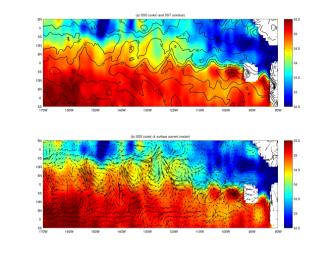New research using salinity data from NASA's Aquarius instrument on the Aquarius/SAC-D observatory has given scientists an unprecedented look at a key factor involved in the formation of an oceanic wave feature in the tropical Pacific and Atlantic Oceans that influences global climate patterns.
Tropical instability waves are westward-traveling waves that form along the interface between areas of cold and warm sea surface temperatures near the equator. Existing studies suggest that these waves can have wavelengths of 1,000-2,000 kilometers and have an average period between waves of about one month. These waves redistribute various properties of seawater within the ocean, including temperature, salinity, nutrients, and carbon. They interact with ocean currents, affect large-scale climate patterns such as El Nino and La Nina, and influence marine ecosystems and the carbon cycle.
Previous observations of tropical instability waves have been limited to satellite observations of sea surface temperature, sea level, ocean surface wind, and ocean surface chlorophyll abundance, as well as sparse direct ocean measurements. Salinity has been found to play an important role in the physics of these waves, and observations of their salinity are important to understanding them and their impacts on climate variability and prediction, and biogeochemistry. However, until now salinity observations of them have been limited to very sparse direct ocean measurements. Aquarius provides an unprecedented opportunity to observe their salinity.
In a study in press in the journal Geophysical Research Letters, a team led by Tong Lee of NASA's Jet Propulsion Laboratory, Pasadena, Calif., and including scientists from Earth & Space Research in Seattle, Aquarius data were used to reveal the salinity structure associated with tropical instability waves in the Pacific Ocean. The figure shows sea surface salinity (color shading in panels a and b) on December 18, 2011, derived from Aquarius measurements, showing the peaks and valleys of tropical instability waves in the eastern to central equatorial Pacific Ocean. The salinity structure is coherent with those obtained from other satellite derived products such as sea surface temperature (contour lines in panel a) and ocean surface currents (arrows in panel b). The unit for the sea surface salinity (SSS) is parts per thousand (the Practical Salinity Unit or PSU). The unit for sea surface temperature (SST) is degree centigrade.
The team found that Aquarius' salinity observations showed a clear signature of the waves near the equator in the Pacific Ocean where large contrasts in salinity occur between the saltier waters of the South Pacific and fresher waters of the North Pacific. The Aquarius data reveal that the waves move much faster at the equator than they do away from the equator, a feature that had not previously been well documented.
Aquarius observations show that near the equator, the waves have a dominant period of approximately 17 days. Aquarius' ability to reveal oceanic features on such short timescales was unexpected, as the mission was designed to study salinity changes on time scales of a month and longer. Salinity variability associated with tropical instability waves is larger near the equator, while sea surface temperature and sea level variability associated with the waves is larger a few degrees away from the equator. Salinity observations from Aquarius can therefore fill an important gap in studying tropical instability waves by providing measurements that are complementary to other satellite observations and direct ocean measurements.
Aquarius was built by JPL and NASA's Goddard Space Flight Center in Greenbelt, Md. JPL managed Aquarius through its commissioning phase and is archiving mission data. Goddard manages Aquarius mission operations and processes science data. CONAE provided the SAC-D spacecraft, an optical camera, a thermal camera with Canada, a microwave radiometer, other sensors and the mission operations center. France and Italy also contributed instruments.
For more information about Aquarius/SAC-D, visit http://www.nasa.gov/aquarius and http://www.conae.gov.ar/eng/principal.html.
Reference:
Lee, T.; G. Lagerloef; M. Gierach; H.-Y. Kao; S. Yueh; and K. Dohan, 2012: "Aquarius reveals salinity structure of tropical instability waves," Geophysical Research Letters, in press.

 Planetary Data System
Planetary Data System












